CD, CD Çalar, DVD, DVD Çalar, SACD, LP, Plak Çeşitleri ve Fiyatları

Go back to the ‘80s with Sample Science Super Lynn Drums, a surprisingly deep and astonishingly affordable LinnDrum-style drum machine plugin.
We talk a lot about the Roland drum machines on Attack. The 707, 808 and 909 are titans in the world of dance music. One drum machine that doesn’t get mentioned as often by techno producers – even though it really should – is the LinnDrum LM-2. Released by Roger Linn under the Linn Electronics moniker in 1982, the sample-based instrument was the rhythm machine to have for disco, post-disco and other downtown club genres in the early ‘80s. It, along with its predecessor the LM-1 and follow-up Linn 9000, remains the go-to sound for anyone making ‘80s-style electronic music. Synthwave literally could not exist without it.
Sample Science Super Lynn Drums
Oddly, unlike Roland’s x0x boxes, which have been emulated endlessly, VSTs of Roger Linn’s epoch-making drum machines are few and far between. That’s why Super Lynn Drums by Sample Science is so welcome. Containing sound sets from all three Linn drum machines – the LM-1, LinnDrum LM-2 and rare Linn 9000 – it gives you immediate access to those famous ‘80s drums. And, it being a Sample Science instrument, there’s more going on than just drum triggering, with a number of unexpected enhancements beyond just the original sounds.
Sample Science Super Lynn Drums: An Overview
Sample Science Super Lynn Drums follows the same layout as the company’s other drum machines. If you’ve used any of their drum-based instruments, you’ll be instantly at home.
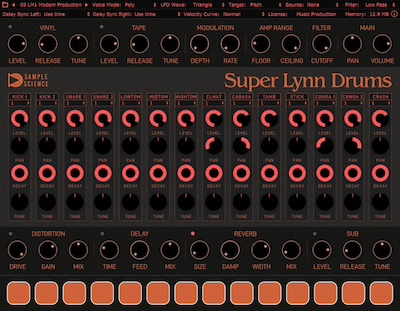
At the center is the main drum machine GUI with slots for 16 drum sounds. Each one has its own volume, pan, decay and tune dials, the latter crucial for Prince-style LM-1 detuned percussion. You can also select individual outputs here, enabling you to send the audio of each channel to its own DAW audio track.
You load sounds in packs of 16, with each one organized by drum machine and style. These run the gamut from the original audio to processed groups like modern production, vintage tape, vintage EQ and even gated reverb. You can’t load up individual sounds, unfortunately, so if you wanted to combine, say, a gated snare with a modern production kick, you’d have to add different instances of Super Lynn Drums to different MIDI tracks. This is not a bad idea anyway, as you’ll probably want to do this to get around the global effects, which we’ll talk about next.
Effects and Modulation
Super Lynn Drums includes quite a few effects and enhancements that let you do a surprising amount of tweaking to the stock sounds.
In terms of effects, there are the usual suspects including distortion, reverb and delay, plus vinyl and tape noise sections. There’s also a Sub circuit for adding bass weight. This works particularly well on kick, snare and toms (although not so much on hats and other percussion, hence why you need to add multiple instances to a project). There’s also a lowpass/highpass filter plus an Amp Range section for injecting reamped room energy. This feature is Super Lynn Drums’ secret weapon, able to take any sound to the next level in terms of presence and punch.
Interestingly for a drum machine, there’s a global LFO, which you can point at Pitch, Pan or Expression. While using it across the stereo output might be a big extreme, it’s highly effective on single sounds for adding movement and energy.
Super Lynn Drums In Use
Let’s use multiple instances of Sample Science Super Lynn Drums to make an ‘80s-inspired beat to use in a synthwave-type track. We could do everything from a single loaded plugin and route audio out individually but we want to use the effects in different ways on each drum sound.
We start with Super Lynn Drums with the LM2 preset loaded for the kick. To give it some weight, we adjust the Amp Range dials to add perceived size, give it a touch of reverb (nothing says ‘80s like reverb on the kick) and then dial in the Sub, tuned to G to match the track.
The LM2 kick:
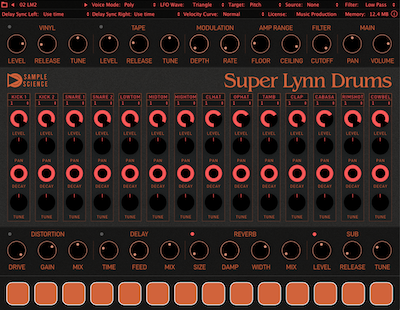
For the snare, we go with the LM2 80s Gate Reverb preset. The gated effect is a bit much for our track so we dial the Decay back halfway. To give it a little high-end buzz we turn on the Tape effect and adjust the Level and Release until it sounds like it’s part of the snare. The Amp Range effect plumps it up even more, with a touch of reverb giving it some space.
The LM2 80s Gate Reverb snare:
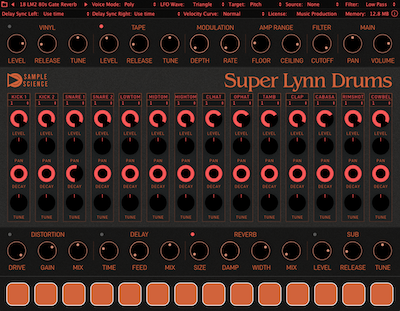
Next the closed hat, again from the LM2 set. To add a little motion we use the Modulation controls with very slow Rate and sober Depth settings, with the LFO employing a sine wave and the destination aimed at Expression. Amp Range and Reverb assist with sound design.
The LM2 closed hats:
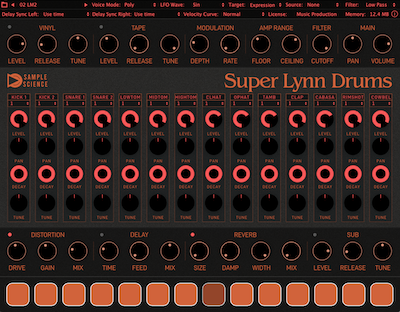
For the open hats, we go back to the LM2 patch. We dial in Amp Range settings to bring it in line with the other sounds and increase the Reverb for a fuller sound. We also pan it to the left slightly to move it out of the way of the closed hats.
The LM2 open hats:
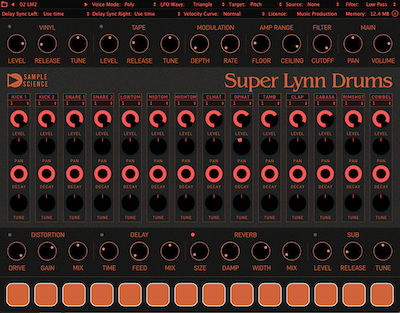
The last sound is a tambourine, again from the LM2 set. We’re using it as an accent at the end of a phrase so we want a sound with character. Accordingly, we use the distortion and delay, plus pan it to the right to help it stand out.
The LM2 tambourine:
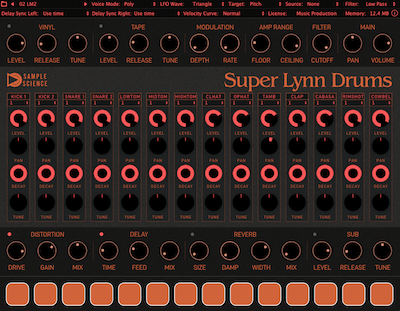
Here’s the beat all together with with some synthwave synths for reference.
The final beat:
The Final Word
Super Lynn Drums is tons of fun. Dialing in useful and punchy sounds is also a breeze thanks to all of the effects and other useful parameters that Sample Science has helpfully included. It would be great if the effects could be applied per sound rather than globally but that’s a sacrifice worth making when you consider the price.
Yes, the price. At only $20, Sample Science Super Lynn Drums is an absolute steal. If you work in ‘80s-inspired genres or just like classic drum machine sounds, it’s worth checking out.
[social-links heading=”Follow Attack Magazine” facebook=”https://www.facebook.com/attackmag” twitter=”https://twitter.com/attackmag1″ instagram=”https://www.instagram.com/attackmag/” youtube=”https://www.youtube.com/user/attackmag” soundcloud=”https://soundcloud.com/attackmag” tiktok=”https://www.tiktok.com/@attackmagazine”]
[product-collection]
attackmagazine

Go back to the ‘80s with Sample Science Super Lynn Drums, a surprisingly deep and astonishingly affordable LinnDrum-style drum machine plugin.
We talk a lot about the Roland drum machines on Attack. The 707, 808 and 909 are titans in the world of dance music. One drum machine that doesn’t get mentioned as often by techno producers – even though it really should – is the LinnDrum LM-2. Released by Roger Linn under the Linn Electronics moniker in 1982, the sample-based instrument was the rhythm machine to have for disco, post-disco and other downtown club genres in the early ‘80s. It, along with its predecessor the LM-1 and follow-up Linn 9000, remains the go-to sound for anyone making ‘80s-style electronic music. Synthwave literally could not exist without it.
Sample Science Super Lynn Drums
Oddly, unlike Roland’s x0x boxes, which have been emulated endlessly, VSTs of Roger Linn’s epoch-making drum machines are few and far between. That’s why Super Lynn Drums by Sample Science is so welcome. Containing sound sets from all three Linn drum machines – the LM-1, LinnDrum LM-2 and rare Linn 9000 – it gives you immediate access to those famous ‘80s drums. And, it being a Sample Science instrument, there’s more going on than just drum triggering, with a number of unexpected enhancements beyond just the original sounds.
Sample Science Super Lynn Drums: An Overview
Sample Science Super Lynn Drums follows the same layout as the company’s other drum machines. If you’ve used any of their drum-based instruments, you’ll be instantly at home.
At the center is the main drum machine GUI with slots for 16 drum sounds. Each one has its own volume, pan, decay and tune dials, the latter crucial for Prince-style LM-1 detuned percussion. You can also select individual outputs here, enabling you to send the audio of each channel to its own DAW audio track.
You load sounds in packs of 16, with each one organized by drum machine and style. These run the gamut from the original audio to processed groups like modern production, vintage tape, vintage EQ and even gated reverb. You can’t load up individual sounds, unfortunately, so if you wanted to combine, say, a gated snare with a modern production kick, you’d have to add different instances of Super Lynn Drums to different MIDI tracks. This is not a bad idea anyway, as you’ll probably want to do this to get around the global effects, which we’ll talk about next.
Effects and Modulation
Super Lynn Drums includes quite a few effects and enhancements that let you do a surprising amount of tweaking to the stock sounds.
In terms of effects, there are the usual suspects including distortion, reverb and delay, plus vinyl and tape noise sections. There’s also a Sub circuit for adding bass weight. This works particularly well on kick, snare and toms (although not so much on hats and other percussion, hence why you need to add multiple instances to a project). There’s also a lowpass/highpass filter plus an Amp Range section for injecting reamped room energy. This feature is Super Lynn Drums’ secret weapon, able to take any sound to the next level in terms of presence and punch.
Interestingly for a drum machine, there’s a global LFO, which you can point at Pitch, Pan or Expression. While using it across the stereo output might be a big extreme, it’s highly effective on single sounds for adding movement and energy.
Super Lynn Drums In Use
Let’s use multiple instances of Sample Science Super Lynn Drums to make an ‘80s-inspired beat to use in a synthwave-type track. We could do everything from a single loaded plugin and route audio out individually but we want to use the effects in different ways on each drum sound.
We start with Super Lynn Drums with the LM2 preset loaded for the kick. To give it some weight, we adjust the Amp Range dials to add perceived size, give it a touch of reverb (nothing says ‘80s like reverb on the kick) and then dial in the Sub, tuned to G to match the track.
The LM2 kick:
For the snare, we go with the LM2 80s Gate Reverb preset. The gated effect is a bit much for our track so we dial the Decay back halfway. To give it a little high-end buzz we turn on the Tape effect and adjust the Level and Release until it sounds like it’s part of the snare. The Amp Range effect plumps it up even more, with a touch of reverb giving it some space.
The LM2 80s Gate Reverb snare:
Next the closed hat, again from the LM2 set. To add a little motion we use the Modulation controls with very slow Rate and sober Depth settings, with the LFO employing a sine wave and the destination aimed at Expression. Amp Range and Reverb assist with sound design.
The LM2 closed hats:
For the open hats, we go back to the LM2 patch. We dial in Amp Range settings to bring it in line with the other sounds and increase the Reverb for a fuller sound. We also pan it to the left slightly to move it out of the way of the closed hats.
The LM2 open hats:
The last sound is a tambourine, again from the LM2 set. We’re using it as an accent at the end of a phrase so we want a sound with character. Accordingly, we use the distortion and delay, plus pan it to the right to help it stand out.
The LM2 tambourine:
Here’s the beat all together with with some synthwave synths for reference.
The final beat:
The Final Word
Super Lynn Drums is tons of fun. Dialing in useful and punchy sounds is also a breeze thanks to all of the effects and other useful parameters that Sample Science has helpfully included. It would be great if the effects could be applied per sound rather than globally but that’s a sacrifice worth making when you consider the price.
Yes, the price. At only $20, Sample Science Super Lynn Drums is an absolute steal. If you work in ‘80s-inspired genres or just like classic drum machine sounds, it’s worth checking out.
[social-links heading=”Follow Attack Magazine” facebook=”https://www.facebook.com/attackmag” twitter=”https://twitter.com/attackmag1″ instagram=”https://www.instagram.com/attackmag/” youtube=”https://www.youtube.com/user/attackmag” soundcloud=”https://soundcloud.com/attackmag” tiktok=”https://www.tiktok.com/@attackmagazine”]
[product-collection]